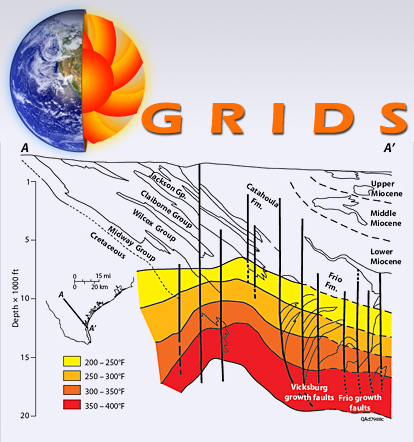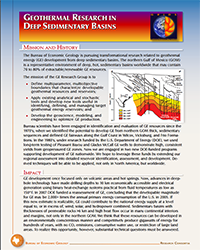Geothermal Research In Deep Sediments (GRIDS)

The Bureau of Economic Geology is pursuing transformational research related to geothermal energy (GE) development from deep sedimentary basins. The northern Gulf of Mexico (GOM) is a representative environment of deep, hot, sedimentary basins worldwide that may contain 70 to 80% of extractable/renewable GE resources.
The mission of the GE Research Group is to:
- Define multiparameter, multiobjective boundaries that characterize developable geothermal resources and reservoirs;
- Apply existing analytical and stochastic tools and develop new tools useful in identifying, defining, and managing target geothermal energy reservoirs;
- and Develop the geoscience, modeling, and engineering to optimize GE production.
Bureau scientists have been engaged in identification and evaluation of GE resources since the 1970’s, when we identified the potential to develop GE from northern GOM thick, sedimentary sequences and defined GE fairways along the Gulf Coast in Wilcox, Vicksburg, and Frio Formations. In the 1980’s, under research funded by the U.S. Department of Energy (DOE), we used long-term testing of Pleasant Bayou and Gladys McCall GE wells to demonstrate high, consistent yields from geopressured GE zones. Now we are engaged in two new DOE-funded programs supporting development of GE nationwide. We hope to leverage these funds by extending our regional assessment into detailed reservoir identification, assessment, and development. Derived techniques will be able to be applied, not only in North America, but worldwide.
Challenges
- Reservoir and reservoir-characteristics identification represents the greatest challenge for development of GE.
- Sustainability of fluid flow and temperature must be assessed so as to explain the economic potential of the resource and define the threshold for investment in GE.
- Management of produced fluids is critical to the economic life of the resource, whether by injection into the producing reservoir to maintain fluid pressure or into a disposal zone to limit potentially adverse environmental impact.
- Use of alternative heat-mining fluids may double extractable heat energy while reducing the cost of heat extraction from geothermal reservoirs. Study of the utility of alternative fluids, including supercritical CO2 and other high-pressure gases, may substantially improve performance and economics of GE production.
- Combining CO2 sequestration with GE production may represent an application that could make CO2 capture from the exhaust streams of coal-fired power plants energy neutral and substantially contribute to global-warming mitigation.
Research Overview Documents
The Potential of Geothermal Energy [PPT]
The Case for Geothermal Energy
Geothermal Resource Potential in Latin America
Geothermal Opportunities and Challenges in Central America
Finding Geothermal Resources: SMU Geothermal Conference 2013
